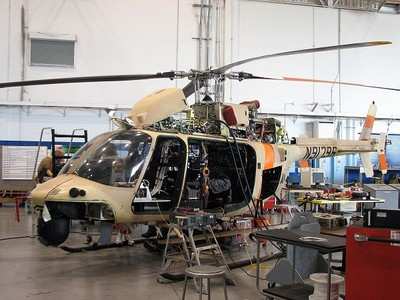Milestone Adds Momentum To Team's Plans To Begin Flight Testing
By Year's End
Northrop Grumman Corporation and Bell Helicopter, have moved a
significant step closer to being able to offer military users a
vertical unmanned system that can ferry cargo - either internally
or externally - over extended distances. On September 17, the team
applied external power for the first time to the main computers and
associated subsystems for its new Fire-X medium-range vertical
unmanned aerial system (VUAS), currently in final integration and
test at Bell Helicopter's Xworx rapid prototyping facility in Fort
Worth, Texas.

Fire-X VUAS
First flight for the new extended range, cargo-hauling VUAS,
which is based on the FAA-certified Bell 407 airframe, is expected
by the end of CY2010. "The Fire-X 'power-on' sequence, which
validates the integrity of the electrical system, went exactly as
planned," said George Spongberg, Northrop Grumman's Fire-X program
manager. "It confirmed that the air vehicle's vehicle management
system has been configured properly, and that all of the air
vehicle's new wire harnesses are delivering power at the right
levels to all of the major subsystems."

Fire-X's new wire harnesses were produced, tested and installed
by Bell Helicopter, he added.
The power-on event follows four months of Fire-X vehicle
modifications at Xworx to convert a commercial Bell 407 from a
piloted vehicle into an unmanned or optionally piloted vehicle. The
modifications included not only removal of non-mission-essential
equipment such as seats and sound insulation, but also installation
of new wire harnesses and avionics required to control the vehicle
in an unmanned configuration. "The challenge," explains Spongberg,
"is to duplicate, using hardware and software, the behavior of the
air vehicle when it is flown by a human. For example, we're
installing and testing actuators that will move the air vehicle's
flight control surfaces in response to commands from a ground
control station the same way they would move in response to
commands from a pilot in the cockpit."
The team is also installing and validating the software that
will perform critical guidance, navigation and control (GN&C)
functions for the new system, he added.

Over the next month, the Northrop Grumman/Bell Fire-X team
expects to conduct preliminary flights of the air vehicle in Fort
Worth in a manned configuration to validate its GN&C system,
then convert it back to an unmanned system. After completion of
ground testing and engine runs, the air vehicle will be ferried, in
an optionally piloted configuration, to the U.S. Army's Yuma
Proving Ground, Ariz. for final testing before Fire-X's first
demonstration flight in an unmanned configuration.
Fire-X is a fully autonomous, four-blade, single-engine unmanned
helicopter that combines the best of two proven air systems in a
low cost, fast-fielding package: the versatile reconnaissance,
surveillance and target acquisition architecture of the U.S. Navy's
MQ-8B Fire Scout vertical takeoff and landing tactical UAV, and the
extended range, payload and cargo hauling capabilities of the
commercially mature Bell 407 helicopter.
 ANN's Daily Aero-Term (12.01.25): Convective SIGMET
ANN's Daily Aero-Term (12.01.25): Convective SIGMET ANN's Daily Aero-Linx (12.01.25)
ANN's Daily Aero-Linx (12.01.25) NTSB Final Report: Remos Aircraft GmbH Remos GX
NTSB Final Report: Remos Aircraft GmbH Remos GX Aero-News: Quote of the Day (12.02.25)
Aero-News: Quote of the Day (12.02.25) ANN's Daily Aero-Term (12.02.25): Coupled Approach
ANN's Daily Aero-Term (12.02.25): Coupled Approach





